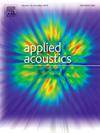Application of ROSI + CLEAN-SC algorithm on the measurement of rotating blade noise and its control
IF 3.4
2区 物理与天体物理
Q1 ACOUSTICS
引用次数: 0
Abstract
Stationary noise sources are localized by the conventional beamforming technique and then by the inverse convolution method to achieve high spatial resolution. As for rotating noise sources, stationary beamforming produces a tail-dragging effect due to the non-stationary nature of the source location. As a time-domain de-Doppler method, the rotating source identifier (ROSI) algorithm achieves an accurate localization of rotating sources. However, its spatial resolution still needs improvements at low and medium frequency bands. This paper applies the CLEAN based on source coherence (CLEAN-SC) algorithm to the ROSI algorithm by extending the time-domain ROSI to the frequency domain and using eigenvalue decomposition to reorganize the ROSI output into cross-spectral matrices (CSMs) and steering vectors (SVs). The effectiveness and applicability of the ROSI + CLEAN-SC algorithm are verified through numerical simulations and experiments on the localization of rotating point noise sources. Finally, this algorithm is applied to measure the rotating blade noise and its control through three different blade modifications, further demonstrating the ability of the ROSI + CLEAN-SC algorithm on real experimental applications.
ROSI + CLEAN-SC算法在旋转叶片噪声测量及控制中的应用
采用常规波束形成技术对静止噪声源进行定位,然后采用反卷积方法实现高空间分辨率。对于旋转噪声源,由于噪声源位置的非平稳性,静止波束形成产生拖尾效应。旋转源识别(ROSI)算法作为一种时域去多普勒方法,实现了对旋转源的精确定位。但是,其在中、低频段的空间分辨率仍有待提高。本文将基于源相干的CLEAN (CLEAN- sc)算法应用于ROSI算法,将时域ROSI扩展到频域,利用特征值分解将ROSI输出重组为交叉谱矩阵(cross-spectral matrices, csm)和转向向量(steering vector, sv)。通过数值模拟和旋转点噪声源定位实验,验证了ROSI + CLEAN-SC算法的有效性和适用性。最后,通过三种不同的叶片改造,将该算法应用于测量旋转叶片噪声及其控制,进一步验证了ROSI + CLEAN-SC算法在实际实验应用中的能力。
本文章由计算机程序翻译,如有差异,请以英文原文为准。
求助全文
约1分钟内获得全文
求助全文
来源期刊

Applied Acoustics
物理-声学
CiteScore
7.40
自引率
11.80%
发文量
618
审稿时长
7.5 months
期刊介绍:
Since its launch in 1968, Applied Acoustics has been publishing high quality research papers providing state-of-the-art coverage of research findings for engineers and scientists involved in applications of acoustics in the widest sense.
Applied Acoustics looks not only at recent developments in the understanding of acoustics but also at ways of exploiting that understanding. The Journal aims to encourage the exchange of practical experience through publication and in so doing creates a fund of technological information that can be used for solving related problems. The presentation of information in graphical or tabular form is especially encouraged. If a report of a mathematical development is a necessary part of a paper it is important to ensure that it is there only as an integral part of a practical solution to a problem and is supported by data. Applied Acoustics encourages the exchange of practical experience in the following ways: • Complete Papers • Short Technical Notes • Review Articles; and thereby provides a wealth of technological information that can be used to solve related problems.
Manuscripts that address all fields of applications of acoustics ranging from medicine and NDT to the environment and buildings are welcome.
 求助内容:
求助内容: 应助结果提醒方式:
应助结果提醒方式:


